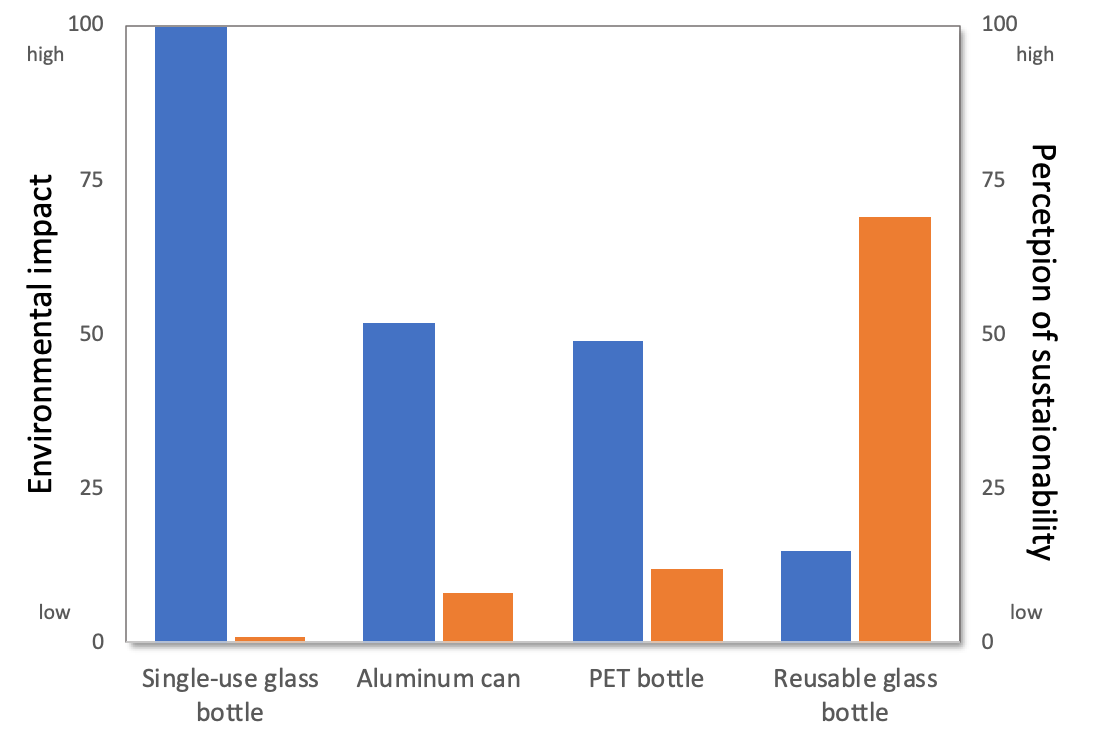Case Study on Beer Packaging
General Presentation
Packaging of beer is an interesting case study, because there is a large variety of existing packaging types and large diversity of End-Of-Life (EOL) scenarios. At the European level one can find: i) deposit systems (Germany), ii) single-use glass bottles (many countries, such as France, Sweden, Spain...), iii) tin can packaging (all countries), iv) plastic packaging (mainly in special contexts, such as in our outdoor events, etc). Many European countries abandoned the deposit systems in the last 40 years. For example, Sweden saw the use of reusable glass bottles fall from 46 to 31% from 1979 to 1997. However, with regards to the environmental impacts of single-use packaging, there is now renewed interest to return to these deposit systems. This is favored by the European strategy to diminish post-consumer waste streams.
In this study, we use the results of a the study of Boesen et al. 2019 using a streamlined-LCA combined with a consumer evaluation of packaging. The compared beer packagings were: glass, aluminium, PET, single use and reusable glass bottles.
This article can also provide you valuable data on liquid packaging in general.
The functional unit was the "containment of 1 hl of beverage". Production and consumer-use are excluded from the scope of the LCA.
Results on environmental footprint
All usual indicators used for LCA of packaging are presented in this study. For purposes of simplification, this table shows the result for Climate Change (CC).
| Type of packaging | CC (kg of CO2,eq per FU) |
|---|---|
| Reusable glass bottle | 14.1 |
| Plastic PET bottle | 46.3 |
| Aluminium can | 51.5 |
| Single-use glass bottle | 96.3 |
- The single-use glass bottle had the highest environmental impact in all categories (except stratospheric soon depletion and ionizing radiation).
- The reusable glass bottle had the lowest environmental impact in all categories.
- PET bottles performed in a number of impact categories similar to the reusable glass bottle, the aluminium cans scored the last preferable.
Different studies exist, confirming the general conclusions, i.e. aluminium and single-use glass packaging are performing worst in an open-loop scenario. However, assuming a closed-loop recycling of aluminum would improve its environmental balance and be more favorable than closed-loop PET recycling considering CC (Simon et al. 2015). However, according to (Amienyo et al. 2013)reusing glass bottles just 3 times would improve CC to the level of aluminium cans and PET bottles.
Results on survey of consumer perception
Boesen et al. 2019 carried out a survey on consumer perception of sustainability by consumers as compared to the LCA results. Figure 1 shows that reusable glass is correctly perceived as sustainable and single-use glass bottles as non sustainable. There is a but a gap between the perception and the actual sustainability of the single-use solutions. Consumers tend to overestimate the environmental impact of aluminium cans and PET bottles.

Figure 1. Comparison between environmental impact evaluated by LCA and perception of sustainability by consumers, adapted from Boesen et al. 2019.
Conclusion
This case-study concludes to the effectiveness of resuable glass bottles from an environmental point of view. However, given the current organization of food distribution and waste collection systems, a change toward this solution would require an organizational change in most countries, with an eventual return to deposit systems.
Advantages in reuse of glass packaging is discussed in the milk packaging case study.
References:
D. Amienyo, H. Gujba, H. Stichnothe, A. Azapagic, Life cycle environmental impacts of carbonated soft drinks, The International Journal of Life Cycle Assessment, 18 (2013) 77-92. online article
S. Boesen, N. Bey, M. Niero, Environmental sustainability of liquid food packaging: Is there a gap between Danish consumers' perception and learnings from life cycle assessment?, Journal of Cleaner Production, 210 (2019) 1193-1206. online article
Note: One of the authors acknowledges financial support by Carlsberg, a beer producer.
B. Simon, M.B. Amor, R. Földényi, Life cycle impact assessment of beverage packaging systems: focus on the collection of post-consumer bottles, Journal of Cleaner Production, 112 (2016) 238-248.online article